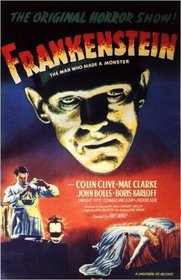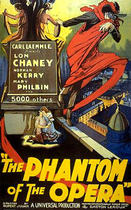Our editor-in-chief Nate Yapp is proud to have contributed to the new book Hidden Horror: A Celebration of 101 Underrated and Overlooked Fright Flicks, edited by Aaron Christensen. Another contributors include Anthony Timpone, B.J. Colangelo, Dave Alexander, Classic-Horror.com's own Robert C. Ring and John W. Bowen. Pick up a copy today from Amazon.com!
Universal Terror II: "Frankenstein"
The success of Dracula caused Universal to believe that a second horror film would be remarkably profitable. The next logical film to make would be an adaptation of Mary Shelley's "Frankenstein." The film was released in December of 1931. Frankenstein told the story of Henry Frankenstein (Colin Clive) who, with his hunchbacked assistant Fritz (Dwight Frye), robs graves. He uses the body parts for his experiments. Henry needs a brain for his experiments, so he sends Fritz to Goldstadt University to acquire a brain. Fritz breaks in and steals a normal brain, but a loud noise frightens him and he drops it. He then steals an abnormal brain for Frankenstein to use in his experiments.
Henry's fiancée, Elizabeth (Mae Clarke), becomes worried about him. He has been gone for a long time. Elizabeth and Henry's friend Victor (John Boles) ask Henry's former teacher about his whereabouts. Dr. Waldman (Edward Van Sloan) does not know either. Waldman, Victor, and Elizabeth go to Henry's castle laboratory to find him. They find Henry completing his experiment. He has created a man from the parts of the dead and is going to animate him through electricity. Henry and Fritz turn on the machines and the body is given life.
When the experiment is over, Waldman warns Henry that the brain taken from the medical school was abnormal. The creature Henry has created (Boris Karloff) enters the lab. Fritz enters carrying a torch and the monster becomes violent. They subdue the monster and lock him up. Later, they hear a scream and see that the monster has killed Fritz. Waldman and Henry decide to kill the monster. Henry then returns home with his father (Fredrick Kerr), and Elizabeth.
Waldman gives the creature a powerful drug to sedate him because he is about to dissect it. The monster awakens and kills Waldman. The monster then escapes into the countryside. In the village, the wedding of Elizabeth and Henry is going along as planned. Meanwhile, the monster accidentally drowns a little girl. At Frankenstein Manor, Victor tells Henry that the monster has terrorized the countryside. Henry hears a loud growl. The monster has entered into Elizabeth's room. Elizabeth faints and the monster escapes.
Henry and the townspeople form a search party to find the creature. Henry searches the mountains and finds him. The monster captures Henry and takes him to an old windmill. The villagers find the monster in the windmill and set fire to it. The monster throws Henry out of a window and the villagers save Henry, taking him back to Frankenstein manor. The flames engulf the monster and the windmill collapses. The monster has supposedly died.
Variety magazine said in their review of the film, "Frankenstein looks like a Dracula plus, touching a new peak in horror plays and handled in production with supreme craftsmanship. Boris Karloff makes a memorable figure of the bizarre monster with its indescribably terrifying face of demonical calm." This view was accurate. The film became more successful than Dracula and became more of an inspiration to the films following it.
As early as 1832, Mary Shelley's novel had been dramatized. In 1910, the first film version of "Frankenstein" was made by Thomas Edison's film company. On February 10, 1930 a version written for the stage by Peggy Webling opened in London. Like Dracula, John L. Balderston wrote an adaptation for American audiences. Garrett Fort and Francis Faragoh wrote a screenplay based on Balderston's adaptation.
Scenario editor Richard Schayer met with director Robert Florey about directing Frankenstein. Florey accepted the job and began making revisions on the script. Robert Florey's additions included Henry Frankenstein's dialogue during the monster's creation. The dialogue included the famous line, "It's alive, it's alive!" and the deleted line, "In God's name! I Know what it feels like to be god!" Florey's greatest contribution to the script was the story element of the "abnormal" brain.
The natural choice for the lead role in Frankenstein was Bela Lugosi. Lugosi was at height of his popularity from Dracula. The studio originally pictured Bela Lugosi playing Henry Frankenstein, but Universal changed their mind. Universal believed that Lugosi would be more recognizable in a monster role. Robert Florey filmed test footage of Bela Lugosi as the Frankenstein monster on the Dracula sets, wearing the monster make up by Jack Pierce. Carl Laemmle, Jr, producer of the film, saw Florey's footage and hated it. He fired Florey from the project. Soon, Bela Lugosi left the project as well. Bela Lugosi despised playing the monster because of the heavy make up and lack of dialogue. Lugosi believed his status as a sex symbol would be damaged by portraying the monster. He said that "any half-wit extra" could play the monster.
The project was turned over to the english director James Whale. James Whale was born on July 22, 1889 in Dudley, England. Whale worked as a cartoonist, painter, actor and set designer before becoming a film director. In 1930 he moved to Hollywood because he was chosen to direct the film Journey's End. Whale had directed the stage version before he was asked to make the film. In 1931 he was selected to direct Frankenstein. He went on to direct three more Universal horror classics. The Old Dark House (1932), The Invisible Man (1933), and Bride of Frankenstein (1935) were all directed by Whale. Whale's other films included Waterloo Bridge (1931), Impatient Maiden (1932), The Kiss Before the Mirror (1932), and Show Boat (1936). In 1937 he directed The Road Back, the sequel to All Quiet on the Western Front. James Whale was a man with strong artistic temperament and a low tolerance for studio politics. Whale was an outspoken homosexual, who did not care about the social taboos of the time. In 1941 he retired from directing and became a recluse. In 1957 he committed suicide by drowning himself in his swimming pool.
Garrett Fort and Francis Faragoh worked with James Whale on the Frankenstein script. Their revisions were made so the screenplay could match Whale's vision of the story. John L. Balderston, Richard Schayer, Peggy Webling, Garrett Fort, Francis Faragoh, and James Whale received credit for the writing. Robert Florey received no film credit for his contributions to the script. Frankenstein was already distributed before Florey could protest.
Bela Lugosi's departure from Frankenstein left James Whale searching for a replacement. The replacement he found was Boris Karloff.
Many years later, Boris Karloff recalled his discovery,
"I was making a picture at Universal when the director of Frankenstein, James Whale, saw me in the commissary and he asked me if I'd like to try for the part of the for the picture, but things had not been so brisk for me that I could afford to turn it down. Jack Pierce experimented with me for several weeks before the screen test and it was his artistry as much as anything I did that clinched the decision."
Boris Karloff was born on November 23, 1887 in Dulwich, England as William Henry Pratt. Boris Karloff came from a family of British diplomats, but he opted to pursue an acting career instead. He emigrated to Canada and toured with acting companies all over North America. William Henry Pratt now went by the stage name "Boris Karloff". Karloff's film debut was as an extra in The Dumb Girl of Portici in 1916. He appeared in dozens of movies and serials throughout the 1920's. Boris Karloff had always known he was a character actor, so he had no reservations about becoming the Frankenstein monster. Following Frankenstein, Boris Karloff became the leading name in horror films. His work for Universal created some of the greatest horror classics of all time. In 1941 he joined the stage production of "Arsenic and Old Lace" spoofing his own monstrous persona. In the late 1940's Karloff teamed with RKO producer Val Lewton and made th Isle of the Deade classic films The Body Snatcher (1945), (1945), and Bedlam (1946). Boris Karloff was able to shed his horror image and appear in such movies as The Secret Life of Walter Mitty (1947), Unconquered (1948), and Tap Roots (1944). In the 1950's he appeared on Broadway as Captain Hook in "Peter Pan" and in "The Lark." He starred in the television series "Colonel March of Scotland Yard" (1957-1958) and "Thriller" (1960-1962). Producer Roger Corman used the aging star in The Raven (1963), The Terror (1963), and The Comedy of Terrors (1964). Boris Karloff's last great role was in Targets (1968) for director Peter Bogdonovich. In Targets, Karloff played an aging horror star that becomes involved with a modern day serial killer. On February 2, 1969, Boris Karloff died of emphysema. At the time of his death, he was one of the most beloved figures of the motion picture community.
Karloff's talent gave the monster a wide spectrum of emotions. The joy, sadness, anger and amazement that Karloff gives the monster shines through the make up by Jack Pierce. To create the Frankenstein monster's strange appearance, Pierce studied antiquated burial techniques, anatomy, and electrodynamics. Jack Pierce designed the monster's distinctive flattened head by reasoning that Frankenstein would go straight to the brain by chopping the top of the skull off. Pierce believed that Karloff's eyes were too lively for the monster, so he weighed down his eyelids with morticians wax. The make up took nearly four hours to apply and at some points Karloff would have to remain in character for periods spanning twenty five hours. The heavy costume weighed forty to forty five pounds total. It worsened a back condition that Karloff got while loading cement for a building supply company in Hollywood.
Colin Clive was chosen to play Henry Frankenstein because James Whale had previously worked with the actor on Journey's End in 1930. Two endings were filmed with Clive for Frankenstein. The original ending had Henry dying from his fall from the windmill. Test audiences hated that ending, so the studio shot another ending with Henry surviving the drop.
The scene of the little girl's drowning was serverly edited for the original release of Frankenstein, The original scene showed the monster and the little girl throwing flowers into a pond. The monster enjoys this game and throws the girl into the pond when they run out of flowers, thinking she will float. When the girl doesn't float, he becomes scared and runs away. When the film was originally released the scene ended with the monster approaching the girl. It was edited because Boris Karloff thought that the scene was too horrible and he did not like the idea of the monster killing the child.
In the opening credits the monster is billed as "?" and Boris Karloff was not invited to attend the premiere, but it is Boris Karloff's portrayal of the monster that made Frankenstein the legend it is today. Frankenstein is a great moral lesson on the dangers of technology. Boris Karloff's character of the monster shows the viewer that man has no business being a god.
| Universal Terror | ||
|---|---|---|
| << Part 1 | Part 2 | Part 3 >> |








